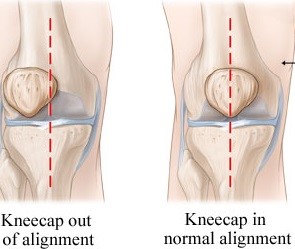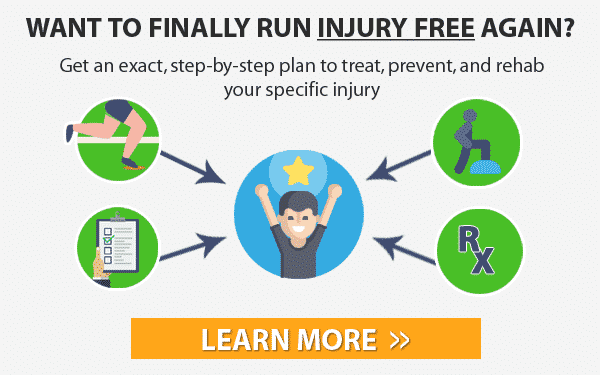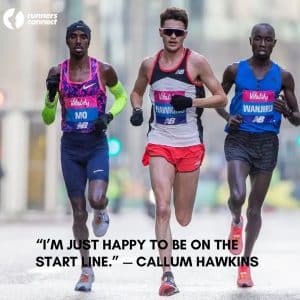Is there any injury more ubiquitous than runner’s knee? It’s within the popular lexicon as one of the eternal enemies of the distance runner.
Aching or stabbing pain around the kneecap has kept runners young and old from enjoying the sport they love.
The good news is that biomechanical research has uncovered ways you can treat runner’s knee. And even prevent it from occurring.
To learn more about biomechanics, please read Introduction To Running Biomechanics.
How Common Is Runner’s Knee?
In a word, very. By a number of measures, runner’s knee, referred to in medical circles as patellofemoral pain syndrome, or PFP is the number one most prevalent running injury. Two large scale scientific studies have confirmed this.
A 2003 study of over 800 runners training for a road race in Canada found that runner’s knee alone accounted for almost one third of all of the injuries sustained by the sample group over the study’s 13 week duration.1 Another study published the year before evaluated over 2,000 injured runners that visited a sports medicine clinic.
Again, runner’s knee was by far the most common injury accounting for twice as many injuries as the next most common problem (IT band syndrome), and made up 17% of all injuries.2
To learn more about ITB, please read IT Band Syndrome in Runners.
Symptoms Of Runner’s Knee
Classically, runner’s knee is characterized by an aching or stabbing pain that’s “inside” or “around” the kneecap. Running, especially down hills, is painful, and descending stairs usually provokes pain, too. The upper or lower edges of your kneecap might be tender to the touch. But there isn’t usually any visible swelling.
When you try to run, it may feel like your knee is about to “give way” and buckle. If you sit for too long with your knee bent, you’ll often develop stiffness and pain on the front of your knee.
It can be a little tricky to determine the cause of your knee pain. Because there are a few other injuries that can cause pain in and around the knee as well. Two other injuries you should rule out are IT band syndrome and a medial meniscus tear.
IT band syndrome causes pain on the outside of the knee. While some soreness may occasionally extend to the outer edge of your kneecap, the primary location of pain is not in the front of the knee.
Meniscus injuries are more common in older runners, and usually causes a catching, locking, or unstable sensation in the knee. They do often swell up.3
If you are unsure whether you have runner’s knee or another knee injury, a doctor or physical therapist can almost always diagnose it without the need for any advanced medical imaging.
For more running related knee injuries, please read Self-Diagnose Your Running Knee Injuries.
What Causes Runner’s Knee?
The tremendous forces transmitted through the knee during running might be one reason why it’s so commonly injured. The knee is the focal point for the quadriceps and hamstring muscles, which produce a large proportion of the energy you need to maintain your speed when you run.
Though runner’s knee is very common, what’s more interesting is why everybody doesn’t get it. Somehow, in healthy runners, the knee is able to handle these huge forces being transmitted through it while running, thousands of times per hour, day after day.
During normal running and walking, the kneecap (the patella, in medical speak) slides up and down a groove in the end of the femur when you straighten and bend your knee. The actual pain associated with runner’s knee is a result of the patella rubbing up against the edges of this groove in the femur, hence the technical term “patellofemoral pain syndrome.”
Planning A Rehab Program For Runner’s Knee
Currently, there are a few biomechanical theories as to what causes the kneecap to rub against the groove in the femur. The traditional explanation has been that abnormal or imbalanced tension from the quadriceps muscle alters the tracking of the kneecap.
This hypothesis is supported by evidence from a seven year study of patients with runner’s knee, which found that restoration of quadriceps strength is associated with a better likelihood of recovery in long standing cases of patellofemoral pain.4
Other research found abnormal activation patterns in the quadriceps on the injured side, providing additional support for this theory.5
Not all researchers agree though. Other evidence points to hip strength and hip muscle coordination as a better explanation for the irritation in the kneecap.6
This might sound counterintuitive. But one innovative study by researchers at the University of Southern California demonstrates how this is possible.
Their study used a special MRI machine to peer inside the knee joint to see what actually happens when you use your knee during weight bearing activity. Essentially the femur, whose position is controlled by the hip muscles rotates underneath the kneecap, which remains more or less stationary.
The Biomechanics Of Runners Knee
For healthy runners the kneecap, or patella, slides up and down a groove in the end of the femur when you straighten and bend your knee.
However, for runners who suffer from runner’s knee, the patella isn’t able to track properly in this groove.
Thus, the patella rubs up against the edges of this groove in the femur and causes the pain you feel with runner’s knee. Hence the technical term for the injury, “patellofemoral pain syndrome.”

Researchers and biomechanics experts have identified a number of potential underlying causes for why the patella doesn’t track properly. These include muscular weakness or strength imbalances and poor movement coordination.
Regardless of the underlying reason, the result is an abnormal alignment or mal-tracking of the patella.
For example, research has demonstrated that a lack of hip strength or hip muscle coordination can cause the femur to internally rotate knee or “collapse” too much, which misaligns the tracking of the patella.
Other studies have shown that quad strength imbalances can alter the tracking of the kneecap, usually because the imbalance causes one side to “pull” a little too much.
Biomechanical studies also demonstrated that runners (particularly women) with runner’s knee are much more likely to have weak hip abductor and external rotator muscles, as well as greater internal knee rotation during running.7
These insights spurred researchers to try treating runner’s knee with hip strength exercises as well as the traditional quadriceps strength exercises.
The results were impressive. A 2011 study found that hip strength training was superior to quadriceps strength training alone in a patellofemoral pain rehab program.8
How To Treat And Prevent Runner’s Knee
If you’ve got runner’s knee, you don’t have time to split hairs debating scientific theories. You just want results.
To this end, the best approach is first starting with a brace that removes the irritation from the patella and then implementing a rehabilitation program that targets each of the three potential biomechanical routes to fixing the abnormal stress on your kneecap.
RunnersConnect Bonus
Download our Top 5 Runner’s Knee Prevention Exercises for Free.
It’s a PDF with the 5 best exercises to help you prevent runner’s knee.
The good news is that new research has uncovered ways you can treat runner’s knee and even prevent it from occurring.
NuNee: A 90% Effective Treatment For Runner’s Knee
It’s not often we see independent clinical research on an injury-prevention device that provides both short-term and long-term relief from an injury.
But, that’s exactly what we’ve got thanks to the Nazareth College School of Physical Therapy in Rochester, NY when they studied one of the latest devices to hit the market,NuNee.
NuNee’s unique design relieves the pressure that each stride places on your patella (your knee cap). And the research reveals, if you relieve the pressure, you will relieve the pain.
So, let’s take a look at those studies…
In 2022, the researchers performed two studies. The first was to determine the immediate effects of using NuNee to relieve runner’s knee within the first 2 weeks.
The second round of research was to determine the effect of using NuNee for 6 weeks to determine if it could help with runner’s knee long-term.
Immediate effects
Participants were screened for anterior knee pain using a standardized musculoskeletal exam to rule out causes of knee pain that would exclude participation. They were then asked to identify their current level of pain on a 0-10 numerical rating scale.
Subjects completed a single functional test including stair ambulation, squat or running, depending on what was most provocative.
They completed testing without any type of brace then with the NuNee device, and a pain rating was recorded during each test scenario to identify immediate response.
When engaging in provocative activity, 89% reported decreased pain immediately after donning the NuNee brace.
Results show a mean score of 3.38 on the numerical rating scale with provocative activity without the brace, and 1.62 with the brace, resulting in significant decreases in reported pain. Five participants also reported improvements in their pain at rest when wearing the brace.
6 week follow-up
After six weeks, participants demonstrated statistically and clinically significant changes in Kujala and numerical rating scale scores. The Kujala test is a 13-item screening instrument designed to assess patellofemoral pain in adolescents and young adults.
During functional testing at follow up, 100% of participants reported pain scores of 0/10 while using the brace.
These findings suggest that the NuNee brace can reduce immediate and long-term pain and improve function when worn during physical activity in individuals with anterior knee pain.
If you are suffering from runner’s knee and want to give NuNee a try, head to nuneeshop.com. They offer a 100% moneyback guarantee if it doesn’t work for you, so there’s no risk to give a it a try.
Long-Term Prevention Of Runner’s Knee
It’s always important to remember that with running injuries, you need to treat the source of the pain and not just the pain.
The NuNee device is fairly unique in the sports-injury world in that it’s one of the few things to provide immediate relief for an injury so that you can continue to train.
But, that doesn’t mean the underlying issues are fixed.
It’s imperative that you also address the underlying quad and/or hip tightness and weakness or you may find yourself stuck with a different running injury you can’t run through.
So, what is the best treatment method?
First up is quad strength. Two main exercises are commonly used in rehab programs to target quad strength.
- Straight leg lift
- Mini squat
For hip strength, the most effective exercises for retraining your hip abductors and external rotators are as follows.
- Glute bridge, ideally with a resistance band around your knees
- Monster walk, which also requires a resistance band
Also, to improve hip coordination, there is one exercise you can do. And one visual cue to use while you run.
Single leg balance on a wobble board or BOSU ball can help translate strength gains into better control of the leg when you run. You can start with one minute of balance. Then build up to two sets of two minutes over time.
Not sure what a wobble board is? Please read Balance Exercises for more.
Finally, here is a great video of an overall Runner’s Knee Prevention Routine you can do
To really translate your gains into running, you need to work on changing your knee mechanics while you run. The best drill for this is to put two short strips of athletic tape on your knees. Next focus on keeping the “face” of the tape pointing forward when you run.
The tape isn’t doing anything special. It’s just providing you with a visual cue to keep your knees pointed forward. When your foot hits the ground, check to see whether your knee buckles inward. If so, you’re still putting extra stress on your knee. Keep those knees pointed straight ahead.
Some research has connected tight quadriceps and calves to the development of runner’s knee. So it’s essential that you also stretch your calves and quadriceps for two sets of 30 seconds each. Do this several times per day.10
Though these exercises are designed for recovering from runner’s knee, you can use a pared down version with fewer sets (if you’re pressed for time) as a way to prevent runner’s knee.
Keeping your hip and quad strength up, as well as stretching and improving your knee mechanics when you run, are all good ways to defend yourself against the number one running injury.
Recovery Time For Runner’s Knee
Runner’s knee is a highly variable injury, so unfortunately there’s no straight answer on how long you’ll need.
If you are young and have a relatively minor case, you might only need a couple of days off. But if you’ve had it for a while, or if your muscular strength and coordination in your quads and hips are very poor, it may take several weeks of diligent rehabilitation work before you’re able to run pain free.
Strength exercises usually take at least four weeks to start having a substantial effect. While many rehab programs are six to twelve weeks long.
Cross Training While Injured and During Recovery
Cross training is recommended while you’re injured and as you slowly return to running.
The best form of cross training for this injury is Aqua Jogging. Studies have shown that aqua jogging can enable a well-trained runner to maintain running fitness for up to 4-6 weeks.
Aqua jogging is a form of deep water running that closely mimics the actual running movement. Your feet don’t actually touch the bottom of the pool, so it is zero impact and safe for almost any type of injury. In my experience, the only time to avoid aqua jogging is when you have a hip flexor injury, which can be aggravated by the increased resistance of the water as you bring your leg up.
Because aqua jogging closely mimics natural running form, it provides a neuromuscular workout that, in addition to aerobic benefits, helps keep the running specific muscles active. The same can’t be said for biking and swimming.
The only downside to aqua jogging is that you need a pool that is deep enough to run in without touching the bottom. If you’re lucky enough to have access to a pool of this size, aqua jogging should be your first cross training choice.
In one study, a group of ten runners trained exclusively with deep water running for four weeks and compared 5km race times pre deep water running and post deep water running.
The researchers found no statistical difference in 5k time or other markers for performance, such as submaximal oxygen consumption or lactate threshold.
In a second study, researchers measured the effects of aqua jogging over a six week period.
This time, 16 runners were separated into two groups – one who did aqua jogging workouts and the other who did over land running.
Using the same training intensities and durations, the researchers found no difference between the groups in maximal blood glucose, blood lactate, and body composition.
It get’s better:
Research has also demonstrated that aqua jogging can be used as a recovery tool to facilitate the repair of damaged muscles after hard workouts.
These findings make aqua jogging an important recovery tool in addition to being the best cross training method for injuries.
Need one more reason?
The calories burned aqua jogging are even higher than running on land, so if you want to avoid weight gain while you take time off from running, this is definitely the exercise for you!
Aqua Jogging Workouts For Runners
If you’re interested in aqua jogging to rehab your injury, then the absolute best way is to use one of my favorite programs, Fluid Running.
First, it comes with an aqua jogging belt and waterpoof bluetooth headphones so you have everything you need to aqua jog effectively.
Second, they have an app that pairs with the headphones so you can get workouts, guided instructions on how to aqua jog properly, and motivation while you’re actually pool running.
This has been an absolute game changer for me when I am injured.
I used to dread aqua jogging workouts because they were so boring and it took all my mental energy to stay consistent.
But, with workouts directly in my ear, it’s changed the whole experience and I actually look forward to the workouts. So much so that I now use aqua jogging as a cross training activity in the summer, even when I am not injured.
Fluid running is an awesome deal when you consider it comes with the belt (highly recommended for better form), the waterproof headphones (game changer for making pool workouts fun), a tether (to add variety to the workouts you can do) and the guided workout app (to make your cross training structure and a whole lot more interesting).
That’s why we’ve partnered with them to give you 2 additional running-specific workouts you can load into the app when you use the code RTTT .
Check out the product here and then on the checkout page, add the code RTTT in the coupon field and the workouts will be added to your order for free.
If you’d rather do the aqua jogging workouts on your own, here are some great ideas to get you started!
Medium Effort Workouts
The Pyramid
10 minutes easy warm up – 1:00 hard, 30 seconds easy – 1:30 hard, 30 seconds easy – 2:00 hard, 30 seconds easy – 2:30 hard, 30 seconds easy, go to 5:00 in 30 second intervals and then come back down the pyramid (4:30 hard, 30 easy, 4:00 hard, 30 easy etc). Finish with 10 minutes easy cool down.
Wave your hands in the air like you just don’t care
10 minutes easy warm up, 1 minute medium (87-92% of maximum heart rate or what feels like tempo effort), 1 minute sprint (95-100% of maximum heart rate or all out sprint), 30 seconds hands in air (keep moving your legs in the running motion, but put your hand above your head), 1 minute rest, Repeat 10-15 times. 10 minutes easy cool down.
Hard Workouts
One of the difficulties of cross training is replicating those truly lung-busting, difficult workouts.
So, if you’re going to be pool running quite a bit due to injury or limited training volume, invest in a bungee cord designed for sprinters.
Tie one end of the resistance band to a sturdy object (pole, lifeguard stand, pool ladder) and bring the other into the water with you.
Put the strap around your waist and begin aqua jog away from your starting point.
You’ll begin to notice the bungee tighten and resist against you (depending on the length of your pool, you may need to wrap the bungee around the supporting object or tie it in knots to make it shorter to feel resistance).
Spend a few moments testing yourself to see how far you can pull the bungee.
This is a great challenge and a fun way to compete with yourself during an otherwise boring cross training activity.
Now for the hard part:
Pick a point on the pool wall or side of the pool that you feel stretches the bungee to a very hard sprint that you could maintain for 60-90 seconds.
This will be your “sprint” marker that you’ll use on sprint intervals (95-100% of maximum heart rate or all out sprint).
Now:
Find a point that feels like the end of a hard tempo run.
Mark this spot as your “medium” interval distance.
When you complete the hard workouts, you can use these reference points to ensure that you maintain a very hard effort.
The springboard
10 minutes easy warm up, 90 seconds easy (slowly moving out and stretching the bungee), 2 minute medium, 1 minute sprint, 1 min rest (let the bungee pull you back – this is kind of fun). Repeat 10 times. 10 minutes easy cool down.
The race simulation
10 minutes easy warm up, 90 seconds easy (slowly moving out and stretching the bungee), 5 minutes medium (focus and concentrate, just like during the hard part of a race), 30 seconds sprint, 2 minutes rest. Repeat 4 times. 10 minutes easy col down
The lactic acid
10 minutes easy warm up, 90 seconds easy (slowly moving out and stretching the bungee), 2 minutes sprint, 90 seconds rest. Repeat 12 times, 10 minutes easy cool down.
I guarantee that with the bungee, you’ll get your heart rate through the roof.
You can challenge yourself and make aqua jogging more fun by seeing how long you can stay at your maximum stretched distance or seeing how far you can push it.
Likewise, if you have a friend who is injured (or someone willing to be a good sport) you can try pulling each other across the pool for some competitive fun.
Cross training can be tough, especially when you’re injured or want to be increasing your volume faster.
However, I hope that providing a variety of workouts, either through the Fluid Running app (which also makes it easier to keep track of the workout while in the water) or on your own can add a fun challenge in the pool and you can emerge from your injury with minimal fitness loss.






One Response
Good article, John. Well thought out. I like the wobble board suggestion. I am a Janda board guy myself, but there’s little difference there. Keep up the research and the writing. Runner’s Knee is a pain for all of us and for women even more so. When you have time, take a look at some of the work that Geno Auriemma’s training team at UConn has done for his b-ball players in reducing ACL injuries big time.
Bill Boland